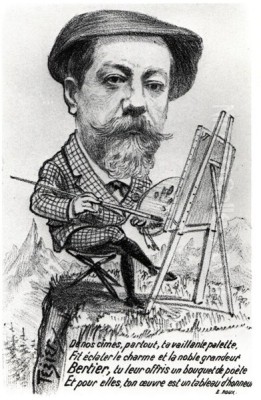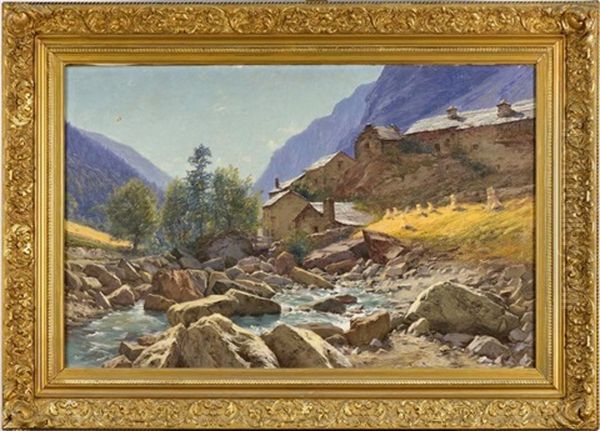
Charles Alexandre Bertier stands as a significant figure in the tradition of French landscape painting, particularly renowned for his dedication to capturing the formidable beauty and grandeur of the Alps. Born in Grenoble in 1860 and passing away in his native city in 1924, Bertier devoted much of his artistic career to interpreting the mountainous terrain that dominated his surroundings, leaving behind a legacy of powerful and evocative Alpine scenes executed primarily in oil. His work offers a window into the late 19th and early 20th-century fascination with high mountain landscapes, blending careful observation with a palpable sense of awe.
Early Life and Artistic Formation in Grenoble
Grenoble, nestled at the foot of the French Alps, provided the perfect crucible for an artist drawn to mountain scenery. Bertier's artistic journey began in this environment, steeped in a regional tradition that respected the power of the local landscape. His formal training was significantly shaped by two key figures who guided his development in landscape and specifically mountain painting.
He studied under Jean Achard (1807-1884), a respected landscape painter associated with the region. Achard, himself influenced by the Dutch masters and the burgeoning Barbizon School's emphasis on naturalism, likely instilled in Bertier a foundation in careful observation and the techniques required to render the complexities of nature. Achard was a pivotal figure in the Dauphinois school of painting, bridging the gap between Neoclassical landscape and a more direct, realistic approach, paving the way for artists like Bertier who sought authenticity in their depictions.
Bertier's specialization in Alpine subjects was further honed under the tutelage of Laurent Guétal (1841-1892), often known as Abbot Guétal (l'Abbé Guétal). Guétal was not only a talented painter but also a Catholic priest, bringing a unique, perhaps more spiritual, perspective to his depictions of the mountains. As one of the pre-eminent mountain painters of the Dauphiné region, Guétal was instrumental in developing the specific skills needed to tackle the challenges of high-altitude light, atmosphere, and geological forms. His guidance undoubtedly encouraged Bertier’s own commitment to the Alpine genre.
The Call of the High Mountains

Bertier was not content to paint the Alps from a distance or from the comfort of a studio based on sketches alone. He was driven by a desire to immerse himself in his subject matter, to understand the mountains intimately. This led him to adopt the practice of painting en plein air (outdoors), directly confronting the landscape he wished to portray. Significantly, he often ventured high into the Dauphiné Alps, part of the larger Massif des Écrins, setting up his easel amidst the peaks and glaciers.
This practice was physically demanding and required considerable dedication. Transporting materials, coping with unpredictable weather, and enduring the thin air and challenging conditions of high altitudes were all part of the process. Yet, this direct engagement allowed Bertier to capture the fleeting effects of light, the subtle shifts in atmospheric conditions, and the sheer scale and texture of the mountain environment with a veracity and immediacy that studio work might lack. He sought not just to replicate the appearance of the mountains but, as suggested by his contemporaries, to convey their deeper meaning and inspire an understanding of their majesty in the viewer.
The Romanche Valley, a dramatic glacial valley carving through the Massif des Écrins, became a particularly important source of inspiration for Bertier. Its towering cliffs, rushing river, and picturesque villages offered a wealth of subjects that resonated with his artistic sensibilities. He returned to this area repeatedly, exploring its different moods and aspects throughout his career.
Artistic Style: Realism, Light, and Alpine Grandeur
Bertier's style is primarily rooted in Realism and Naturalism, consistent with the traditions passed down by Achard and the broader trends in 19th-century landscape painting. His works demonstrate a meticulous attention to detail, accurately rendering rock formations, snow textures, and the specific quality of Alpine light. He possessed a strong ability to convey the immense scale and geological structure of the mountains, giving his paintings a sense of solidity and permanence.
While grounded in realism, Bertier's work also shows sensitivity to the atmospheric and luminous effects that were central concerns for the Impressionists, such as Claude Monet and Alfred Sisley. Although not an Impressionist himself in terms of technique or theory, Bertier clearly understood the importance of light in defining form and creating mood. His paintings often capture the crisp clarity of high-altitude air, the dramatic play of sun and shadow across slopes, or the soft, diffused light of an overcast day or an approaching storm.
His compositions emphasize the grandeur and sometimes the overwhelming power of the natural world. He often employed perspectives that highlight the verticality and vastness of the peaks, sometimes dwarfing any human elements present, if included at all. This aligns with the Romantic concept of the Sublime – the feeling of awe mixed with a hint of terror experienced when confronting the immense power of nature, a theme explored earlier by artists like J.M.W. Turner and the Swiss Alpine specialist Alexandre Calame. Bertier’s interpretation, however, tends towards a more objective, though still deeply felt, representation compared to the heightened drama of some Romantics.
Compared to some other prominent Alpine painters of his era, Bertier maintained a relatively consistent realistic approach. He did not embrace the bolder stylizations, Symbolist overtones, or Divisionist techniques seen in the Alpine works of contemporaries like the Swiss Ferdinand Hodler or the Italian Giovanni Segantini. Nor did he adopt the sometimes more picturesque or illustrative style of the prolific English-German painter Edward Theodore Compton. Bertier's strength lay in his faithful yet sensitive portrayal of the specific character of the Dauphiné Alps.
Representative Works and Enduring Themes
Several specific works exemplify Bertier's focus and skill. His paintings inspired by the Romanche Valley are particularly notable. Vallée de la Romanche au Pied-du-Col, completed around 1894, likely depicts a scene near a mountain pass, showcasing his ability to handle the complex interplay of rock, vegetation, and perhaps the river or road winding through the valley floor under the gaze of imposing peaks.
Another work from the same period, Les Fréaux près de la Grave (1894), focuses on a specific location near the village of La Grave, a renowned mountaineering centre in the heart of the Massif des Écrins, dominated by the formidable peak of La Meije. Such paintings would capture the unique atmosphere of these high Alpine settlements nestled within dramatic landscapes.
L'approche de l'orage en Suisse (Approaching Storm in Switzerland), dated 1900, demonstrates his interest in capturing the dynamic and sometimes threatening aspects of mountain weather. This work likely aimed to convey the tension and changing light preceding a storm, showcasing his ability to render atmospheric drama and evoke an emotional response in the viewer, fulfilling his stated goal of helping contemporaries understand the mountains.
A painting titled Une allée dans un paysage de montagne (An Alley in a Mountain Landscape), an oil on canvas measuring 65 x 100 cm, suggests a potentially more intimate view, perhaps focusing on a path or track leading the viewer's eye into a broader mountain scene. This title hints at the interplay between human passage and the vastness of nature that often characterizes landscape painting.
Across his oeuvre, recurring themes include the dazzling effect of sunlight on snow and ice, the intricate textures and colours of rock faces, the vastness of Alpine panoramas, and the profound silence and solitude of the high mountains. His work consistently celebrates the unique beauty and power of the Alpine world.
Context: The Dauphinois School and the Fascination with the Alps
Bertier worked during a period when the Alps were transitioning from remote, often feared regions into destinations for tourism, scientific exploration, and mountaineering. This growing interest fueled a demand for images of the mountains, and artists played a crucial role in shaping public perception of these landscapes. Bertier was part of a regional artistic milieu often referred to as the Dauphinois School or the School of Grenoble, which included several artists dedicated to depicting their local environment.
While Jean Achard and Laurent Guétal were direct influences, other artists from Grenoble, though perhaps working in different genres, contributed to the city's artistic reputation, such as the academic painter Ernest Hébert or the celebrated still-life and portrait painter Henri Fantin-Latour. Bertier's specific focus, however, placed him firmly within the specialized tradition of Alpine painting.
His commitment to direct observation aligned with the broader Realist movement and the plein air practices popularized by the Barbizon School painters like Théodore Rousseau and Camille Corot, and later adopted and transformed by the Impressionists. However, Bertier applied these principles to a subject matter far more challenging and monumental than the forests of Fontainebleau or the riverbanks of the Seine. His work can be seen as a regional expression of these wider artistic currents, adapted to the unique demands of the Alpine landscape. He provided a French counterpoint to the Alpine traditions developing in Switzerland, Italy, Austria, and Germany.
Legacy and Recognition
Charles Alexandre Bertier earned recognition during his lifetime as a skilled and dedicated painter of the Alps. His work was exhibited, and he established a reputation particularly within his native region and among those interested in Alpine subjects. His paintings captured the specific character of the Dauphiné Alps with an authenticity born of deep familiarity and direct experience.
His works are held in museum collections, notably the Musée de Grenoble, which, given his lifelong connection to the city and his subject matter, is a fitting repository for his art. The mention in the source material of his work being in the collection of the J.B. Castagnino Museum (Museo Castagnino) in Rosario, Argentina, while requiring specific verification for individual pieces, points towards a potential broader reach or acquisition history for his paintings, possibly through collectors or expatriates.
While perhaps not as internationally famous as some avant-garde figures of his time or Alpine specialists like Hodler or Segantini, Bertier holds a secure place in the history of French landscape painting and, more specifically, in the rich tradition of Alpine art. He represents the dedicated regional artist who finds profound inspiration in their immediate environment and develops the specialized skills needed to portray it effectively.
His legacy lies in his powerful, honest depictions of the French Alps. He successfully conveyed both their physical presence – the rock, snow, and light – and their intangible qualities of majesty, solitude, and enduring power. Through his canvases, Charles Alexandre Bertier continues to offer viewers a compelling vision of the high mountains he knew so well. He died in Grenoble in 1924, leaving behind a significant body of work dedicated to the Alpine world.